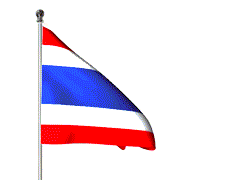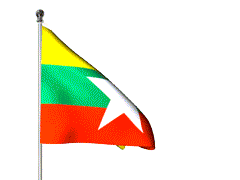Information
Consular
Visa (references)
Scholar (references)
Tourism Information
Shwedagon Pagoda
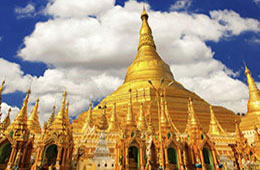 In the city of Yangon, you will find the beautifully majestic Shwedagon Pagoda. The Shwedagon Pagoda sits upon holy Singuttara Hill. To understand the reason why this hill is considered so holy, and to grasp the significance of the Shwedagon to Buddhists and to the people of Myanmar, it is important to know both the history and the legends of how it all came to be. Over 2,500 years ago, there lived a king by the name of Okkalapa. He was ruler of Suvannabhumi and ruled over the Talaings. At this time, Siddharta Guatama was living in northern India. He was still a young man and was not yet recognized as the Buddha. It was and is believed that a new Buddha, or “Enlightened One”, will come into being once every 5,000 years. At the time of Okkalapa, it had been approximately 5,000 years since the last Buddha, and it was considered time once again.
In the city of Yangon, you will find the beautifully majestic Shwedagon Pagoda. The Shwedagon Pagoda sits upon holy Singuttara Hill. To understand the reason why this hill is considered so holy, and to grasp the significance of the Shwedagon to Buddhists and to the people of Myanmar, it is important to know both the history and the legends of how it all came to be. Over 2,500 years ago, there lived a king by the name of Okkalapa. He was ruler of Suvannabhumi and ruled over the Talaings. At this time, Siddharta Guatama was living in northern India. He was still a young man and was not yet recognized as the Buddha. It was and is believed that a new Buddha, or “Enlightened One”, will come into being once every 5,000 years. At the time of Okkalapa, it had been approximately 5,000 years since the last Buddha, and it was considered time once again.
Singuttara Hill is important because it was the holy resting spot of the relics of three Buddhas. Their relics were enshrined within Singuttara Hill, thus making it a holy place. To keep it holy, it was believed that gifts given by the new Buddha, which would become relics, had to be enshrined every 5,000 years in the hill.
But Okkalapa was concerned, as a new Buddha had not come to be known yet, and if it took too long he feared the hill could lose its holiness. He went to the hill to pray and to meditate, unaware of Siddharta Guatama’s coming into enlightenment under the Bodhi tree in northern India at the same time.
According to area legend, he appeared to Okkalapa and told him to be patient, that his wish for the hill would soon be granted.
As Guatama was reaching the end of his 49 days of meditation, he was visited by two brothers. Their names were Tapussa and Bhallika, and they happened to be from Myanmar and were subjects of Okkalapa. These two merchant brothers present Guatama Buddha with a gift of some honey cake, as they recognized him as The Enlightened One.\To express his thanks to them, he pulled out 8 of his hairs off of his head, and gave the hairs to Tapussa and Bhallika. They took the hairs and headed back home. However, during their journey they were twice robbed, and 4 of the sacred hairs were taken from them. By the time they reached Myanmar, they had only 4 of The Buddha’s hairs left.
However, their return was still a celebrated one by King Okkalapa and his people, and a large party was thrown in honor of the brothers. It was decided that a shrine place should be built on Singuttara Hill to house these newest relics. At the party in their honor, the brothers presented a casket containing the Buddha’s hairs to their king, and he opened it.
there were great tremors upon the earth, a great rocking earthquake. It is also said that all of the trees then burst into blossom and lovely jewels fell from the sky.
A shrine was created on Singuttara Hill to house these 8 miraculous hairs, and the area was deemed sacred. An enormous pagoda was then created atop the hill to house the shrine, and it is considered one of the most sacred places in all of Myanmar. The pagoda itself is a wondrous architectural achievement. The top soars well over 300 ft into the air (approximately 100 meters or more) above the hilltop and can be seen from quite far away. The Shwedagon, which means, loosely translated, “golden hills” is magnificently made out of gold and jewels all over.
Some interesting stories of the Shwedagon Pagoda deal with its enormous bells. In 1608, a Portuguese invader by the name of Philip de Brito y Nicote stole a bell that weighed in at around 6,0000 lbs, or 30 tons. However, as he was attempting to return home with the bell, it fell into the Bago River and was lost.
The bell was replaced in 1779. That was after a massive earthquake in 1768 toppled the highest part of the pagoda. Once that part, the stupa, was rebuilt, King Hsinbyushin’s son Singu had a 23 ton bronze bell cast. It was called the Maha Gandha bell. In the 1820’s, however, British soldiers plundered the pagoda, and stole this bell.
En route to Calcutta, the bell fell overboard and sank into the sea. It was later recovered and now sits atop the pagoda platform, on the northwest side.
Finally, in 1841 another bell was created, this one weighing approximately 8,000 pounds (40 tons) and covered with 45 lbs (20kg) of gold plating. This bell, called the Maha Tissada bell, still resides in the pagoda, on the northeast side of the enclosure.
The years of 1852 through 1929 mark a time of British military occupation in Myanmar, with colonial rulers controlling the areas. However, the people of Myanmar were still able to have full access to the Shwedagon. In 1871 a new diamond-studded piece for the pagoda’s structure was donated by King Mindon of Mandalay. The people of Myanmar were thrilled at this tribute and well over 100, 00 of them gathered at Shwedagon to celebrate. And although this made the British military somewhat uncomfortable, they had to allow it as the people were honoring their faith.
It is evident that, over the centuries, the Shwedagon Pagoda has survived difficult times. It has withstood earthquakes, invasions, pillaging, foreign occupation and an internal stairwell fire in 1931 that destroyed many ancient monuments. Another earthquake in 1970, which was the 9th that the area had sustained since the 1500’s, led the government to begin a renovation project on the crown of the main pagoda.
Each disaster brought damage to the pagoda, but it has always withstood the onslaughts and endured the renovations. The fact that Shwedagon has survived these times of hardship and damage and still stood firm adds to its sense of majesty. It also adds to the sense of pride within the people of Myanmar, that nothing can truly leave lasting damage upon this beloved site. And people have always pitched in to make sure that any needed renovations took place to strengthen and secure it. Thus, to this day it sits, strong and steady, mystical and sacred, high upon a sacred hill.
Sule Pagoda
 All of us who live in Yangon know where Sule Pagoda is. But as we say in Myanmar language ကပ္ေက်ာ္ ေစတီ( bypass pagoda) because we usually go around the Sule traffic roundabout and seldom visit it. Even few know about the interesting history behind this ancient pagoda. According to legends King Thiha Dipa who was king of neighbouring Thiha Dipa Kingdom(now Thanlyin) commanded one his ministers to build a pagoda where the Sule Pagoda now stands. The name of this minister was “Ah Thoke(အ သုတ္)” and hence this pagoda was called Kyaik Ah Thoke(က်ိဳက္ အ သုတ္). Kyaik in the Mon language is pagoda and Ah Thoke being the name of the minister who built it. But some scholars says Ah Thoke really translate as “Buddha’s Holy Hair” and call it “Holy Hair Pagoda” Others say that this was a place where King Okkalapa( of ancient Okkalapa Kingdom) gathered with his ministers to search for a place to place the Holy Hairs of Buddha before deciding on the Sangguttara Hill where the Shwedagon Pagoda now stands. As it was a place of gathering it was call စု ေဝး ေစ တီ (pagoda where all gathered). However there are also many scholars who say that it was a place where the 4 Guardian Nats of the Universe gathered and should be called ေလးဆူ ေစ တီ(Laysu Zedi) which later evolved into ဆူး ေလ ေစ တီ(Sule Zedi). But whatever the history now we see the Sule Pagoda glittering on a small hillock right in the middle of Yangon Central Business District. The compound of Sule Pagoda is 2,181 acres: 322 feet from east to west and 291 feet from north to south. The height to the top of the diamond bud is 151 feet. The Sule Pagoda has a unique shape. It is octagonal, i.e the plint has eight pointed sides in the 8 directions of the compass meaning the Noble Eight-fold Paths To Enlightenment (မဂၢင္ရွစ္ပါး) plus many symbols on the pagoda that shows the way to Nirvana. In ancient times Sule Pagoda was said to be outside the actual Yangon city established by King Alaungpaya in 1755 and surrounded by mud flats and muddy water prone to regular flooding from the nearby river. And many Buddhist monasteries surrounded the solitary hillock. According to ancient text the western entrance reached up to present day Bo Ywe Street(ဗိုလ္ရြဲလမ္း). And numerous small islands dotted around in what now is the Maha Bandoola Park until the end of the 1st Anglo-Myanmar War of 1824. There was also a bridge made of rock to access the pagoda across the waters(the township where the Sule Pagoda stands is still being call Kyauktada which means rock bridge). There was supposed to be another pagoda by the name of Kyaik Myat Than Cho(က်ိဳက္ ျမတ္ သံ ခ်ိဳ) to the southwest of the pagoda too and the place was always crowded with pilgrims. But after the 2nd Anglo-Myanmar War of 1852 the victorious British colonial powers seized Yangon(Rangoon at that time) and decided to make it the administrative and commercial capital of British Burmah and made plans for extending the city. The Commissioner of Yangon(Rangoon) Sir Arthur Phayre then commissioned Lt. Fraser of Bengal Engineers and Surgeon Montgomerie to come up with a master plan. The British started by levelling the ground, filling up the low-lying areas and also evicted many monasteries around the Sule Pagoda. About 50 of them were relocated to mango forest to the west. This area is now known as Thayettaw Kyaung Taik (Mango Forest monastery) which is opposite the present day Institute of Medicine(I) on Bogyoke Aung San Road. The British demolished the nearby Kyaik Myat Than Cho(က်ိဳက္ ျမတ္သံ ခ်ိဳ) Pagoda but left the Sule Pagoda intact as a focal point and a landmark of downtown Yangon. One famous pavilion on the compound of Sule Pagoda is the Pavilion of the Sule Bo Bo Gyi(Grandfather Nat of Sule). According to legends this nat is said to be so old that he had been able to pay homage to all four Buddhas that had appeared in this world. It was siad in the Shwedagon Pagoda chronicles that he was the one who directed the Sacred Hairs of Lord Buddha to be buried at Sanguttira Hill where the world famous Shwedagon Pagoda now stands. Many Myanmar people believe that he has powers to help them in their actions and commercial enterprises and his pavilion is always crowded. Others says that he is one of the guardians of Buddhism and is entitled to receive homage from the devotees. There are also many astrologers on the northern stairways for those interested to foresee their future.
All of us who live in Yangon know where Sule Pagoda is. But as we say in Myanmar language ကပ္ေက်ာ္ ေစတီ( bypass pagoda) because we usually go around the Sule traffic roundabout and seldom visit it. Even few know about the interesting history behind this ancient pagoda. According to legends King Thiha Dipa who was king of neighbouring Thiha Dipa Kingdom(now Thanlyin) commanded one his ministers to build a pagoda where the Sule Pagoda now stands. The name of this minister was “Ah Thoke(အ သုတ္)” and hence this pagoda was called Kyaik Ah Thoke(က်ိဳက္ အ သုတ္). Kyaik in the Mon language is pagoda and Ah Thoke being the name of the minister who built it. But some scholars says Ah Thoke really translate as “Buddha’s Holy Hair” and call it “Holy Hair Pagoda” Others say that this was a place where King Okkalapa( of ancient Okkalapa Kingdom) gathered with his ministers to search for a place to place the Holy Hairs of Buddha before deciding on the Sangguttara Hill where the Shwedagon Pagoda now stands. As it was a place of gathering it was call စု ေဝး ေစ တီ (pagoda where all gathered). However there are also many scholars who say that it was a place where the 4 Guardian Nats of the Universe gathered and should be called ေလးဆူ ေစ တီ(Laysu Zedi) which later evolved into ဆူး ေလ ေစ တီ(Sule Zedi). But whatever the history now we see the Sule Pagoda glittering on a small hillock right in the middle of Yangon Central Business District. The compound of Sule Pagoda is 2,181 acres: 322 feet from east to west and 291 feet from north to south. The height to the top of the diamond bud is 151 feet. The Sule Pagoda has a unique shape. It is octagonal, i.e the plint has eight pointed sides in the 8 directions of the compass meaning the Noble Eight-fold Paths To Enlightenment (မဂၢင္ရွစ္ပါး) plus many symbols on the pagoda that shows the way to Nirvana. In ancient times Sule Pagoda was said to be outside the actual Yangon city established by King Alaungpaya in 1755 and surrounded by mud flats and muddy water prone to regular flooding from the nearby river. And many Buddhist monasteries surrounded the solitary hillock. According to ancient text the western entrance reached up to present day Bo Ywe Street(ဗိုလ္ရြဲလမ္း). And numerous small islands dotted around in what now is the Maha Bandoola Park until the end of the 1st Anglo-Myanmar War of 1824. There was also a bridge made of rock to access the pagoda across the waters(the township where the Sule Pagoda stands is still being call Kyauktada which means rock bridge). There was supposed to be another pagoda by the name of Kyaik Myat Than Cho(က်ိဳက္ ျမတ္ သံ ခ်ိဳ) to the southwest of the pagoda too and the place was always crowded with pilgrims. But after the 2nd Anglo-Myanmar War of 1852 the victorious British colonial powers seized Yangon(Rangoon at that time) and decided to make it the administrative and commercial capital of British Burmah and made plans for extending the city. The Commissioner of Yangon(Rangoon) Sir Arthur Phayre then commissioned Lt. Fraser of Bengal Engineers and Surgeon Montgomerie to come up with a master plan. The British started by levelling the ground, filling up the low-lying areas and also evicted many monasteries around the Sule Pagoda. About 50 of them were relocated to mango forest to the west. This area is now known as Thayettaw Kyaung Taik (Mango Forest monastery) which is opposite the present day Institute of Medicine(I) on Bogyoke Aung San Road. The British demolished the nearby Kyaik Myat Than Cho(က်ိဳက္ ျမတ္သံ ခ်ိဳ) Pagoda but left the Sule Pagoda intact as a focal point and a landmark of downtown Yangon. One famous pavilion on the compound of Sule Pagoda is the Pavilion of the Sule Bo Bo Gyi(Grandfather Nat of Sule). According to legends this nat is said to be so old that he had been able to pay homage to all four Buddhas that had appeared in this world. It was siad in the Shwedagon Pagoda chronicles that he was the one who directed the Sacred Hairs of Lord Buddha to be buried at Sanguttira Hill where the world famous Shwedagon Pagoda now stands. Many Myanmar people believe that he has powers to help them in their actions and commercial enterprises and his pavilion is always crowded. Others says that he is one of the guardians of Buddhism and is entitled to receive homage from the devotees. There are also many astrologers on the northern stairways for those interested to foresee their future.
Maha Wi Zaya Pagoda or Mahavijaya Pagoda
 This was built in 1980 as a replica of Shwezigon Pagoda at Nyaung Oo (Bagan). It is near the Shwedagon Pagoda, and the site is on the hillock where Queen Shin Saw Pu used to meditate and recite prayers whenever she visited Shwedagon. It contains relics of Buddha donated by the king of Nepal while visiting Myanmar . The construction design is mixed with modern and classic. There is a picture on the ceiling showing the positions of the constellation at the beginning of construction.
This was built in 1980 as a replica of Shwezigon Pagoda at Nyaung Oo (Bagan). It is near the Shwedagon Pagoda, and the site is on the hillock where Queen Shin Saw Pu used to meditate and recite prayers whenever she visited Shwedagon. It contains relics of Buddha donated by the king of Nepal while visiting Myanmar . The construction design is mixed with modern and classic. There is a picture on the ceiling showing the positions of the constellation at the beginning of construction.
Botataung Pagoda
 Botataung Pagoda is a 40m golden spire and houses another sacred Buddha’s hair relic. The interior is covered with mosaic glass, and dozens of glass showcases display donated marble, gold, teak, silver and limestone artifacts and relics. It has located in east of Yangon waterfront.
Botataung Pagoda is a 40m golden spire and houses another sacred Buddha’s hair relic. The interior is covered with mosaic glass, and dozens of glass showcases display donated marble, gold, teak, silver and limestone artifacts and relics. It has located in east of Yangon waterfront.
Kaba Aye Pagoda
 Kaba Aye (World Peace) Pagoda built for the Sixth Buddhist Synod in 1954-1956. Nearby is a large artificial cave, Maha Pasana Guha or Great Cave, for religious ceremonies and get-togethers.
Kaba Aye (World Peace) Pagoda built for the Sixth Buddhist Synod in 1954-1956. Nearby is a large artificial cave, Maha Pasana Guha or Great Cave, for religious ceremonies and get-togethers.
Taunggyi
 Taunggyi is the capital of Shan State and it is the land of the Shans and other national races, namely, Pa-O, Kachin, Padaung, Danu, Wa, Lahu, Kaw, Maingtha, Padaung, Taungyo, Yin, Gon, Kayah, Lishau and Inntha with their unique cultures. The Shan plateau is about 3,000 to 4,000 feet above sea level. Some ranges are 5,000 to 7,500 feet high, with even higher peaks. A cool climate makes it a highly popular summer resort. Its temperatures range from around 60 degrees Fahrenheit in the cool months of December and January, to 70 or 80 even in the warmest months of April, May, June and July.
Taunggyi is the capital of Shan State and it is the land of the Shans and other national races, namely, Pa-O, Kachin, Padaung, Danu, Wa, Lahu, Kaw, Maingtha, Padaung, Taungyo, Yin, Gon, Kayah, Lishau and Inntha with their unique cultures. The Shan plateau is about 3,000 to 4,000 feet above sea level. Some ranges are 5,000 to 7,500 feet high, with even higher peaks. A cool climate makes it a highly popular summer resort. Its temperatures range from around 60 degrees Fahrenheit in the cool months of December and January, to 70 or 80 even in the warmest months of April, May, June and July.
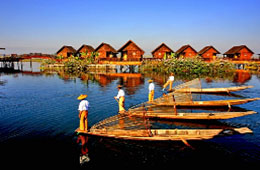 Inle Lake is the most famous scenic spot in the Shan State. It is about 30 km south of Taunggyi, capital of the Shan State. The Lake is 22.4 km long and 10.2 km wide, shallow and extremely picturesque. It is studded with floating islands formed by the growth and decay of vegetation. Sheltered among the hazy blue mountains, the Lake is about 900 metres above sealevel. The lake is very popular with foreign tourists. It is famous for its unique leg-rowers, floating villages and colourful markets and festivals. Even when it is not festival time, it is very interesting to observe the Innthas live on the lake with their houses on stills, floating farms and the floating markets. The Innthas have become so adapted to the lake environment that they build their homes over the water on stills, they build floating farms on the lake and villagers row their long, narrow boats with unique way of leg-rowing that has made them famous.
Inle Lake is the most famous scenic spot in the Shan State. It is about 30 km south of Taunggyi, capital of the Shan State. The Lake is 22.4 km long and 10.2 km wide, shallow and extremely picturesque. It is studded with floating islands formed by the growth and decay of vegetation. Sheltered among the hazy blue mountains, the Lake is about 900 metres above sealevel. The lake is very popular with foreign tourists. It is famous for its unique leg-rowers, floating villages and colourful markets and festivals. Even when it is not festival time, it is very interesting to observe the Innthas live on the lake with their houses on stills, floating farms and the floating markets. The Innthas have become so adapted to the lake environment that they build their homes over the water on stills, they build floating farms on the lake and villagers row their long, narrow boats with unique way of leg-rowing that has made them famous.
Mount Popa
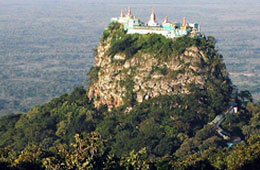 In 442 B.C., a great earthquake roared through central Myanmar – and from out of the barren Myingyan plains rose Mount Popa. Volcanic ash on the mountain slope gradually became fertile soil, and the peak blossomed with flowers of many colors. (Popa is the Sanskrit word for “flower.”) For the inhabitants of the surrounding regions, the “sugar-loaf’ peak becaml regarded as the home of the gods, the Mount Olympus of Myanmar. Alchemist and occultists made their home on the mountain slopes, and others were con vinced mythical beings lived in the woods and among the flowers. So it was a matter of course when Mount Popa became the focus of national nat worship and the official home of the MahagiriNats during the reign in Bagan of King Thinlikyaung. Mount Popa, 1,518 meters (4,981 feet high, is located about 50 km (31 miles southeast of Bagan. It’s a 200-kyat Jeep trip from Bagan village, or a fatiguing bus trip requiring transfers in Nyaung U and Kyaukpadaung. Overnight visitors can stay at the ancient Popa monastery at the foot of the peak, however. During the month of Nayon (May/June) the annual Festival of the Spirits is held here, and it is said that at that time the abbot of the Popa monastery runs the largest hotel in the whole of Myanmar. While the volcanic cone can be climbed by means of a path beginning at the monastery, it should be attempted only by the physically fit. The mountain rises about 1,000 meters (3,280 feet) above the surrounding plain, and given the hot, dry climatic conditions that prevail in central Myanmar, the ascent can be arduous. On clear days, however, the view from the top across the vast dry plain is the most beautiful panorama that can be seen in central Myanmar. The goal of a trip to Mount Popa should be to see the shrine of the MahagiriNats, situated about halfway up the mountain. For seven centuries preceding the reign of Anawrahta, all kings of central Myanmar were required to make a pilgrimage here to consult with the two nats regarding their reign .
In 442 B.C., a great earthquake roared through central Myanmar – and from out of the barren Myingyan plains rose Mount Popa. Volcanic ash on the mountain slope gradually became fertile soil, and the peak blossomed with flowers of many colors. (Popa is the Sanskrit word for “flower.”) For the inhabitants of the surrounding regions, the “sugar-loaf’ peak becaml regarded as the home of the gods, the Mount Olympus of Myanmar. Alchemist and occultists made their home on the mountain slopes, and others were con vinced mythical beings lived in the woods and among the flowers. So it was a matter of course when Mount Popa became the focus of national nat worship and the official home of the MahagiriNats during the reign in Bagan of King Thinlikyaung. Mount Popa, 1,518 meters (4,981 feet high, is located about 50 km (31 miles southeast of Bagan. It’s a 200-kyat Jeep trip from Bagan village, or a fatiguing bus trip requiring transfers in Nyaung U and Kyaukpadaung. Overnight visitors can stay at the ancient Popa monastery at the foot of the peak, however. During the month of Nayon (May/June) the annual Festival of the Spirits is held here, and it is said that at that time the abbot of the Popa monastery runs the largest hotel in the whole of Myanmar. While the volcanic cone can be climbed by means of a path beginning at the monastery, it should be attempted only by the physically fit. The mountain rises about 1,000 meters (3,280 feet) above the surrounding plain, and given the hot, dry climatic conditions that prevail in central Myanmar, the ascent can be arduous. On clear days, however, the view from the top across the vast dry plain is the most beautiful panorama that can be seen in central Myanmar. The goal of a trip to Mount Popa should be to see the shrine of the MahagiriNats, situated about halfway up the mountain. For seven centuries preceding the reign of Anawrahta, all kings of central Myanmar were required to make a pilgrimage here to consult with the two nats regarding their reign .
Sagaing Bridge
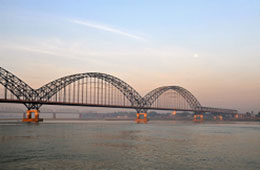 Sagaing lies 21 km south-west of Mandalay on the west bank of the Ayeyarwady River. Sagaing became a capital of an independent Shan kingdom around 1315 after the fall of Bagan had thrown central Myanmar into chaos. Its period of importance was short for in 1364 the founder’s grandson, ThadoMinbya, moved his capital across the river to Inwa. For four brief years from 1760 to 1764 Sagaing was once again the capital. Today, Sagaing is known as a meditation centre. Myanmars, ail over the country would visit Sagaing for the purpose of religious retreat.
Sagaing lies 21 km south-west of Mandalay on the west bank of the Ayeyarwady River. Sagaing became a capital of an independent Shan kingdom around 1315 after the fall of Bagan had thrown central Myanmar into chaos. Its period of importance was short for in 1364 the founder’s grandson, ThadoMinbya, moved his capital across the river to Inwa. For four brief years from 1760 to 1764 Sagaing was once again the capital. Today, Sagaing is known as a meditation centre. Myanmars, ail over the country would visit Sagaing for the purpose of religious retreat.
Sagaing Hill
 It is known as a religious retreat where over 600 monasteries for monks and nuns are located for Buddhistic studies and meditation. The Padamyazedi dates from 1300 while the OnhminThonze or thirty caves pagoda has many Buddha images in a crescent shaped colonnade. Mural paintings ean be seen in the Tilawkaguru cave temple which was built around 1672. The Pa Ba Gyaung is typical of the many monasteries on the hillside. And at the nearby village of Ywahtaung you can see silver workers producing bowls and other silver items by traditional methods.
It is known as a religious retreat where over 600 monasteries for monks and nuns are located for Buddhistic studies and meditation. The Padamyazedi dates from 1300 while the OnhminThonze or thirty caves pagoda has many Buddha images in a crescent shaped colonnade. Mural paintings ean be seen in the Tilawkaguru cave temple which was built around 1672. The Pa Ba Gyaung is typical of the many monasteries on the hillside. And at the nearby village of Ywahtaung you can see silver workers producing bowls and other silver items by traditional methods.
Thabyedan Fort
Just to the left of the bridge, on the Mandalay and Inwa side, is the fort of Thabyedan which was built as a last ditch defence by the Myanmar before the third Anglo-Myanmar war.
Kaunghmudaw Pagoda
 This huge pagoda is 10 km beyond the town of Sagaing. The enormous dome rises 46 metres(151 feet) in the shape of a perfect hemisphere and was modelled after the Mahaceti Pagoda in Ceylon. Also known as Rajamanisula, the pagoda was built in 1636 to commemorate Inwa’s establishment as the royal capital of Myanmar. Around the base of the pagoda are 812 one and a half metre high stone pillars. The 86 lines of Myanmar inscriptions on the slab record details of the pagoda’s construction.
This huge pagoda is 10 km beyond the town of Sagaing. The enormous dome rises 46 metres(151 feet) in the shape of a perfect hemisphere and was modelled after the Mahaceti Pagoda in Ceylon. Also known as Rajamanisula, the pagoda was built in 1636 to commemorate Inwa’s establishment as the royal capital of Myanmar. Around the base of the pagoda are 812 one and a half metre high stone pillars. The 86 lines of Myanmar inscriptions on the slab record details of the pagoda’s construction.
Tupayon Pagoda
Constructed by King Narapati of Inwa in 1444, the Tupayon is of an unusual style for Myanmar consisting of three circular storeys each encircled with arched niches.
Aungmyelawka Pagoda
Situated on the riverfront, near Tupayon, this pagoda was built in 1783 by Bodawpaya on the site of his residence before he became king. It is built entirely of sandstone in imitation of the Shwezigon Pagoda at Nyaung-Oo in Bagan. It is also knows as the Eindawya Pagoda.
Datpaungzu Pagoda
It is comparatively recent but houses many relics from other, older pagodas which were demolished when the railway was built through Sagaing.
Ngadatkyee Pagoda
This was built in 1657 and houses a fine and very large seated Buddha image.
Hsinmyashin Pagoda
It is known as the Pagoda of Many Elephants. It Is built in 1429 . Badly damaged in an earthquake in 1485, It was subsequently repaired but suffered even worse damage in a quake in 1955.
Amarapura
Situated about 11 km south of Mandalay, Amarapura is an ancient capital of the Konbaung Dynasty. The modern town of Amarapura is often referred to as Taungmyo “the southern city” to distinguish It from Mandalay, the northern city. The old name means “city of immortality” but Amarapura’s period as capital was brief. Amarapura was founded as his new capital by Bodawpaya in 1783, soon after he ascended to the throne. In 1823 Bagyidaw moved back to Inwa. In 1841 Amarapura again became the capital but in 1857 Mindon decided to make Mandalay the capital and the changeover was completed in 1860. There are several interesting sltes to be seen. Amarapura was also the slte for the first British embassy in Myanmar in 1795. Amarapura is noted for silk and cotton weaving and bronze easting.
Patodawgyi Pagoda
Built by Bagyidaw in 1820 this well preserved pagoda stood outside the old city walls. The lower terraces have marble slabs illustrating scenes from the Jataka. You’ll have a fine view over the surrounding countryside from the upper terrace. An inscription stone, within the temple precincts, details the history of the pagoda’s construction.
Palace Ruins
Little remains of the old Amarapura palace but you can still find two masonry buildings — the treasury building and the old watchtower. King Bagyidaw and King Bodawpaya were both buried here and their tombs also remain. The corner pagodas still stand at the four corners of the once square city.
U Bein’s Bridge
 South of the Patodawgyi Pagoda the shallow Taungthaman Lake is crossed by a huge teak bridge. During the dry season the bridge crosses dry land. U Bein was the “mayor” at the time of the shift from Inwa and he wisely salvaged material from the deserted Inwa Palace to build this km long footbridge. It has stood the test of time for two centuries.
South of the Patodawgyi Pagoda the shallow Taungthaman Lake is crossed by a huge teak bridge. During the dry season the bridge crosses dry land. U Bein was the “mayor” at the time of the shift from Inwa and he wisely salvaged material from the deserted Inwa Palace to build this km long footbridge. It has stood the test of time for two centuries.
KyauktawgyiPaya Temple (built 1853-78)
 KyauktawgyiPaya (or Pagoda), the pagoda of the Great Marble Image,is sited near the southern entry to Mandalay Hill. Although its construction was started in 1853 by King Mindon, it was not completed until 1878, in part due to a palace rebellion and domestic disturbances in the mid-1860s. Originally it was to be styled after the AnandaPahto in Bagan; the completed Paya, however, bears no resemblance to that massive structure. The chief feature of the KyauktawgyiPaya is huge seated Buddha figure sculpted from a single block of pale green marble from the Sagyin quarry twelve miles north of Mandalay. Reportedly it took 10,000-12,000 men thirteen days to transport the stone block from the Ayeyarwady to the site of the pagoda where it was carved. There are reports, whether true or not, that a canal to float the stone was dug the from the Ayeyarwady to the site, but lacking sufficient height of the water 10,000 conscript labors were ordered into the canal to raised the level of the water. The statue itself was dedicated in 1865. A covered corridor leads through the garden of the arhats to the structure housing the Buddha. On each of the four sides there are twenty shrines with figures representing the arhats, the eighty Great Disciples of the Buddha. Each October one of the largest festivals is held at the KyauktawgyiPaya.
KyauktawgyiPaya (or Pagoda), the pagoda of the Great Marble Image,is sited near the southern entry to Mandalay Hill. Although its construction was started in 1853 by King Mindon, it was not completed until 1878, in part due to a palace rebellion and domestic disturbances in the mid-1860s. Originally it was to be styled after the AnandaPahto in Bagan; the completed Paya, however, bears no resemblance to that massive structure. The chief feature of the KyauktawgyiPaya is huge seated Buddha figure sculpted from a single block of pale green marble from the Sagyin quarry twelve miles north of Mandalay. Reportedly it took 10,000-12,000 men thirteen days to transport the stone block from the Ayeyarwady to the site of the pagoda where it was carved. There are reports, whether true or not, that a canal to float the stone was dug the from the Ayeyarwady to the site, but lacking sufficient height of the water 10,000 conscript labors were ordered into the canal to raised the level of the water. The statue itself was dedicated in 1865. A covered corridor leads through the garden of the arhats to the structure housing the Buddha. On each of the four sides there are twenty shrines with figures representing the arhats, the eighty Great Disciples of the Buddha. Each October one of the largest festivals is held at the KyauktawgyiPaya.
Inwa Bridge
 A few km south of Amarapura the Inwa Bridge spans the Ayeyarwaddy to Sagaing. It’ at present the only bridge across the Ayeyarwaddy though another bridge crossing the river is now under construction near the city of Pyay (Prome). Just south of the bridge, the Myitnge River flows into the Ayeyarwaddy and south of this river stands the ancient city of Inwa. A channel, known as the MyitthaChaung, was cut across from the Myitnge to the Ayeyarwaddy to make Inwa into an island. From 1364, Inwa was the capital of a Myanmar kingdom for nearly 400 years until the shift was made to Amarapura in 1841. It Opened in 1934 the bridge was put out of action by the British in 1942 when they demolished two spans in order to deny the bridge to the advancing Japanese. Not until 1954 was the bridge repaired and put back into operation. There’s a toll to take cars across the bridge which also carries the rail line..Inwa Bridge used to be the longest-bridge in Myanmar until the emergence of Thanlyin Bridge in 1993.
A few km south of Amarapura the Inwa Bridge spans the Ayeyarwaddy to Sagaing. It’ at present the only bridge across the Ayeyarwaddy though another bridge crossing the river is now under construction near the city of Pyay (Prome). Just south of the bridge, the Myitnge River flows into the Ayeyarwaddy and south of this river stands the ancient city of Inwa. A channel, known as the MyitthaChaung, was cut across from the Myitnge to the Ayeyarwaddy to make Inwa into an island. From 1364, Inwa was the capital of a Myanmar kingdom for nearly 400 years until the shift was made to Amarapura in 1841. It Opened in 1934 the bridge was put out of action by the British in 1942 when they demolished two spans in order to deny the bridge to the advancing Japanese. Not until 1954 was the bridge repaired and put back into operation. There’s a toll to take cars across the bridge which also carries the rail line..Inwa Bridge used to be the longest-bridge in Myanmar until the emergence of Thanlyin Bridge in 1993.
Watch Tower
The 27 metre (90 feet) high masoruy watch tower, the Nanmyint is remains of the palace built by Bagyidaw – it’s the “leaning tower of In-wa”.
Naha AunlpnyeBonzan
Also known as the Ok Kyaung this is a masonry monastery built by the chief queen of Bagyidaw for her royal abbot NyaungganSayadaw in 1818. Monasteries were normally built of wood. Although this monastery was built in imitation of the traditional wooden style, its masonry construction has ensured its survival. The 1838 earthquake badly damaged it but in 1837 it was restored.
What else to see
Farms, villages, monasteries and ruined pagodas are scattered around the area within the old city walls, the walls are in particularly good condition near the northern gate, facing the Ayeyarwaddy. This was known as the Gaung Say Daga or “hair-washing”gate since kings had their hair ceremonially washed at this gate.
The Htilamgshin Pagoda dates back to the Bagan period and in a shed near the pagoda stands an inscription recording the consruction of the wooden palace during the first Inwa dynasty. The BagayaKyaung is a wooden monastery of a later period than the masonaryMahaAungmyeBonzan. To the south side of the clty stand the remains of the huge four-storeyLayhtatgyi Pagoda. There is also the Lawkatharaphu Pagoda whtie to the south of the city stands the Inwa fort.
Mingun
It is about 11 km upriver from Mandalay on the opposite bank of the Ayeyarwaddy and accessible only by river. A 45-minute boat trip to Mingun is very pleasant with plenty of life on the river to see.
 If King Bodawpaya had succeeded in his grandiose scheme Mingun might now have the world’s largest pagoda. When Bodawpaya died in 1819 construction was abandoned. Each side of the enormous base measures 72 metres (235 feet) and the lowest terrace measures 140 metres (450 feet). There are projecting arches on each of the four sides.
If King Bodawpaya had succeeded in his grandiose scheme Mingun might now have the world’s largest pagoda. When Bodawpaya died in 1819 construction was abandoned. Each side of the enormous base measures 72 metres (235 feet) and the lowest terrace measures 140 metres (450 feet). There are projecting arches on each of the four sides.
Pondawpaya
Closer to the riverbank a little downstream from the Mingun Pagoda is this five metre (15 feet) high working model for the gigantic structure. It gives a clear picture of just what Bodawpaya intended to achieve.
Hsinbyume or Myatheindan Pagoda
 Built by King Bagyidaw in 1816, three years before he succeeded Bodawpaya as king, the pagoda was constructed in memory of his senior wife the Hsinbyume princess. It is built as a representation of the Sulamani Pagoda which, according, to the Buddhist plan of the cosmos, stands atop Mount Meru. The seven wavy terraces around the pagoda represent the seven mountain ranges around Mount Meru. This pagoda was badly damaged in 1838 by a quake but King Mindon restored it in 1874.
Built by King Bagyidaw in 1816, three years before he succeeded Bodawpaya as king, the pagoda was constructed in memory of his senior wife the Hsinbyume princess. It is built as a representation of the Sulamani Pagoda which, according, to the Buddhist plan of the cosmos, stands atop Mount Meru. The seven wavy terraces around the pagoda represent the seven mountain ranges around Mount Meru. This pagoda was badly damaged in 1838 by a quake but King Mindon restored it in 1874.
Settamra Pagoda
Close to the riverbank downstream from the Pondawpaya model, the hollow, vaulted shrine has a footprint of the Buddha which was brought to Mingun by King Bodawpaya when the relic chamber in the base of his huge pagoda was sealed up. The temple was built in 1811.
Mingun Bell
 In 1790 Bodawpaya had a gigantic bell cast to go with his gigantic pagoda. Weighing 90 tons it is claimed to be the largest hung, uncracked bell in the world. The bell is about four metres high and over flvemetres (15 feet) in diameter at the lip. You can scramble right inside it and some helpful bystander will give it a good thump so you can hear the ring from the interior.
In 1790 Bodawpaya had a gigantic bell cast to go with his gigantic pagoda. Weighing 90 tons it is claimed to be the largest hung, uncracked bell in the world. The bell is about four metres high and over flvemetres (15 feet) in diameter at the lip. You can scramble right inside it and some helpful bystander will give it a good thump so you can hear the ring from the interior.
Kyaikhtiyo Pagoda
 The famous legendary Pagoda on the Goldern Rock about 160 Km from Yangon and 11 km of hiking from the base camp at Kyaikhto. Visitors can also go by car up to a point about a mile away from the Pagoda.
The famous legendary Pagoda on the Goldern Rock about 160 Km from Yangon and 11 km of hiking from the base camp at Kyaikhto. Visitors can also go by car up to a point about a mile away from the Pagoda.
Ngapali Beach
 The beautiful Ngapali Beach is located in Thandwe (Sandoway) about an hour flight from Yangon. This unspoilt beach stretches over 3 Km and an ideal place for everyone who loves seasand and sun or swimming, snorkelling or carefree loitering on the beach exploring or just sitting amidst whistling wind.
The beautiful Ngapali Beach is located in Thandwe (Sandoway) about an hour flight from Yangon. This unspoilt beach stretches over 3 Km and an ideal place for everyone who loves seasand and sun or swimming, snorkelling or carefree loitering on the beach exploring or just sitting amidst whistling wind.
Kyaing Tonge
KyaingTonge, a capital city in Eastern Shan Stute, is known for its scenic beauty and colourful hill tribes. The 0 road from Tachilek to KyaingTongeinds 160 km over the mountains, forests, streams and tribal viliages. -Places of- interest in KyaingTonge include Maha-Myat-Muni Pagoda; Naung–Tong,Lake, Sunn-TaungMonostery, Hot spring and One Tree Pagoda. Loi-mwe, meaning misty mountsin over l600 meters-above the sea level is located 33 km away from KyaingTonge.
Mrauk U
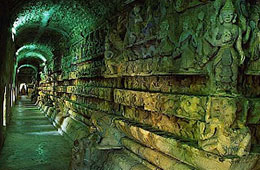 The ancient city of Rakhine Kingdom (15th century is known for its old temples with wall paintings of Indian cultural influence Mrauk-U is reached by boot along the capital of Rakhine State. A boat trip takes about 5 hours. The highlights of Mrauk-U are the massive Shitthaung-paya, a curtously, remarkable temple with countless. Buddha imeges and reliefs, the fortress-like temple Htaukkan-thein noted for the interesting stone sculptures temple And aw-thein with its unique stone carvings and floral designs; Sakya-man-aung, a tall atternuatedstupa; did Archaeologicol.Museum.
The ancient city of Rakhine Kingdom (15th century is known for its old temples with wall paintings of Indian cultural influence Mrauk-U is reached by boot along the capital of Rakhine State. A boat trip takes about 5 hours. The highlights of Mrauk-U are the massive Shitthaung-paya, a curtously, remarkable temple with countless. Buddha imeges and reliefs, the fortress-like temple Htaukkan-thein noted for the interesting stone sculptures temple And aw-thein with its unique stone carvings and floral designs; Sakya-man-aung, a tall atternuatedstupa; did Archaeologicol.Museum.
ChaungTha Beach
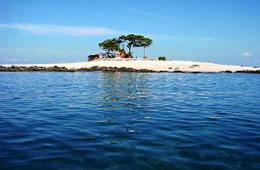 It is a pleasure to visit the unspoiled ChaungTha Beach. Just half-a-day drive from Yangon viaPathein .Sightseeing: – Po Kalar Island – The Phyu Island – KyaukMaungNhama – Specialities: – a variety of seafoods – crayfish and lobster To double your pleasure there, you can stay in comfoft at ChaungTha Beach Hotel(Bungalow- Type). The beach is in West Pathein Township, Ayeyarwaddy Division. The news is encouraging. Myanmar will have one more new seaside resort in Rakhine State in addition to existing unspoilt, beautiful Ngapali, Chaungtha, Maungmagan and Setse beaches. The new beach is named “Kannthaya” and goes well with its name, for “Kann” literally means “seaside” or “beach” and “thaya” implies “pleasant” or “beautiful”. Located 17 miles north of Gwa, the largest township in the southernmost part of Rakhine coastal strip, the new resort can be reached within a few hours’ drive from Yangon. It stretches 8,000 yards with clean, clear, blue and shallow water and with glistening and dazzling sand which will be appreciated by nature-lovers and travellers at home and abroad. New bungalows, a golf course and world standard hotels are under construction now to provide all possible modern facilities creating the beach to appear as a really attractive seaside resort to be thriving in the near future.
It is a pleasure to visit the unspoiled ChaungTha Beach. Just half-a-day drive from Yangon viaPathein .Sightseeing: – Po Kalar Island – The Phyu Island – KyaukMaungNhama – Specialities: – a variety of seafoods – crayfish and lobster To double your pleasure there, you can stay in comfoft at ChaungTha Beach Hotel(Bungalow- Type). The beach is in West Pathein Township, Ayeyarwaddy Division. The news is encouraging. Myanmar will have one more new seaside resort in Rakhine State in addition to existing unspoilt, beautiful Ngapali, Chaungtha, Maungmagan and Setse beaches. The new beach is named “Kannthaya” and goes well with its name, for “Kann” literally means “seaside” or “beach” and “thaya” implies “pleasant” or “beautiful”. Located 17 miles north of Gwa, the largest township in the southernmost part of Rakhine coastal strip, the new resort can be reached within a few hours’ drive from Yangon. It stretches 8,000 yards with clean, clear, blue and shallow water and with glistening and dazzling sand which will be appreciated by nature-lovers and travellers at home and abroad. New bungalows, a golf course and world standard hotels are under construction now to provide all possible modern facilities creating the beach to appear as a really attractive seaside resort to be thriving in the near future.
KyaikKhaHmi – Set-Se Beach
KyaikKhaHmi is a small town situated on the Tanintharyi Coast, South-West of Thanbyuzayut. And the town is very famous for its “Ye Lei Pagoda”. There also the beautiful beach called “Set-Se” and it is very contenient for everyone to take bus drive from Mawlamyaing within a couple of hours.
MoungMagan Beach
 MoungMagan Beach is in Dawei Township also on the Tanintharyi Coastal region. There ia an aerogare for domestic flights. Ayeyarwady Princess Cruise The first luxurious and comfortable cruise along the Ayeyarwaddy River from Mandalay to Bagan has been launched by Barani Hotel and Trading Group Ltd on 2nd November, ’94 at Bagayar Jetty, Yangon. The boat which is constructed by United Engineering Co., Ltd (Union of Myanmar) is named Ayeyarwady Princess and has 30 fully air-conditioned rooms, buffet dining, sun deck and cocktail on board. It is learnt that the Ayeyarwady Princess can accommodate 120 passengers. Enquiries can be made for more information at Barani Hotel & Trading Group Ltd., No. 7l, Min Ye Kyawswa Road, Ahlone Township, Yangon. Tel: 95-01-20854, 95-01-23104. One can also sail down the Ayeyarwady by riverboat from Mandalay to Bagan, a 165 Kilometres downstream, wondrous journey.
MoungMagan Beach is in Dawei Township also on the Tanintharyi Coastal region. There ia an aerogare for domestic flights. Ayeyarwady Princess Cruise The first luxurious and comfortable cruise along the Ayeyarwaddy River from Mandalay to Bagan has been launched by Barani Hotel and Trading Group Ltd on 2nd November, ’94 at Bagayar Jetty, Yangon. The boat which is constructed by United Engineering Co., Ltd (Union of Myanmar) is named Ayeyarwady Princess and has 30 fully air-conditioned rooms, buffet dining, sun deck and cocktail on board. It is learnt that the Ayeyarwady Princess can accommodate 120 passengers. Enquiries can be made for more information at Barani Hotel & Trading Group Ltd., No. 7l, Min Ye Kyawswa Road, Ahlone Township, Yangon. Tel: 95-01-20854, 95-01-23104. One can also sail down the Ayeyarwady by riverboat from Mandalay to Bagan, a 165 Kilometres downstream, wondrous journey.
Embassy Websites
Yangon Time
Bangkok Time
Contact Us
No. 110, Sathon nua Road, Bangkok, 10500, Thailand.
Phone: 0626283892, 022340320, 026379404
Fax: 02 236 6896, 02 233 7250
Email: [email protected]
Website: mebangkok.org
